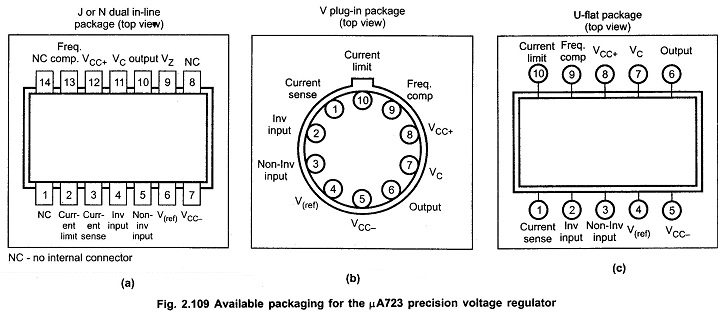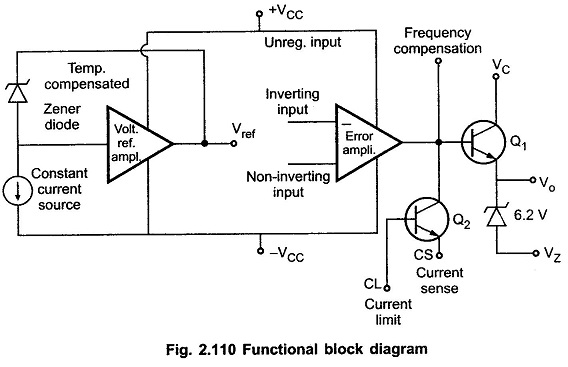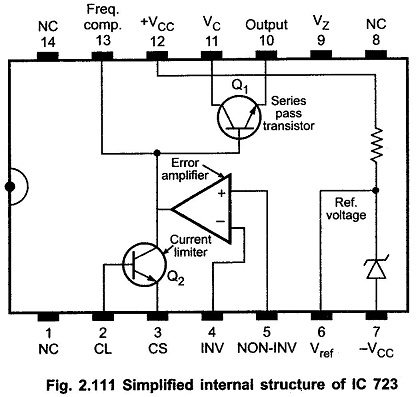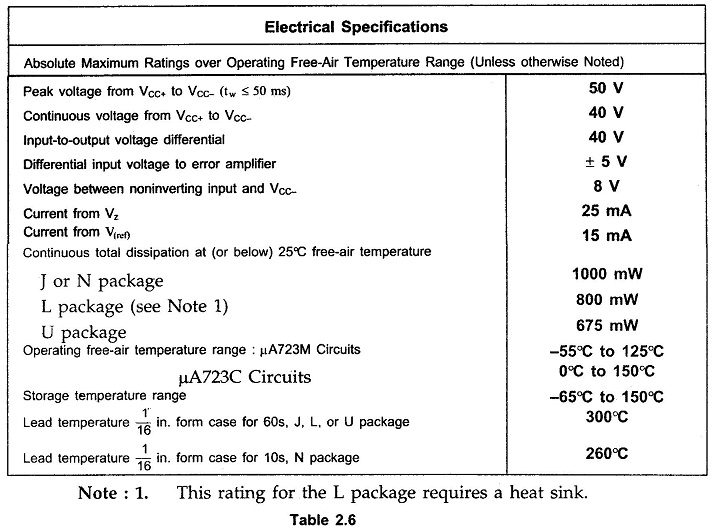IC 723 Voltage Regulator:
The popular general purpose precision regulator is IC 723. It is a monolithic linear integrated circuit in different physical packages. The pin diagram of IC 723 Voltage Regulator along with the various packages is shown in the Fig. 2.109 (a), (b) and (c).
Features of IC 723:
- It works as voltage regulator at output voltage ranging from 2 to 37 volts at currents upto 150 mA.
- It can be used at load currents greater than 150 mA with use of suitable NPN or PNP external pass transistors.
- Input and output short-circuit protection is provided.
- It has good line and load regulation (0.03%).
- Wide variety of applications of series, shunt, switching and floating regulator.
- Low temperature drift and high ripple rejection.
- Low standby current drain.
- Small size, lower cost.
- Relative ease with which power supply can be designed.
- It provides a choice of supply voltage.
Functional Block Diagram of IC 723:
The functional block diagram of IC 723 Voltage Regulator can be divided into four major blocks:
- Temperature compensated voltage reference source, which is zener diode.
- An op-amp circuit used as an error amplifier.
- A series pass transistor capable of a 150 mA output current.
- Transistor used to limit output current.
The functioning of the above blocks can be explained with the help of a simplified functional block diagram of IC 723 Voltage Regulator as shown in the Fig. 2.110.
Temperature compensated zener diode, constant current source and reference amplifier constitutes the reference element. In order to get a fixed voltage from zener diode, the constant current source forces the zener to operate at a fixed point.
Output voltage is compared with this temperature compensated reference potential of the order of 7 volts. For this Vref is connected to the non-inverting input of the error amplifier.
This error amplifier is high gain differential amplifier. It’s inverting input is connected to the either whole regulated output voltage or part of that from outside. For later case a potential divider of two scaling resistors is used. Scaling resistors help in getting multiplied reference voltage or scaled up reference voltage.
Error amplifier controls the series pass transistor Q1, which acts as variable resistor. The series pass transistor is a small power transistor having about 800 mW dissipation. The unregulated power supply source (< 36V d.c.) is connected to collector of series pass transistor.
Transistor Q2 acts as current limiter in case of short circuit condition. It senses drop across Rsc placed in series with regulated output voltage externally.
The frequency compensation terminal controls the frequency response of the error amplifier. The required roll-off is obtained by connecting a small capacitor of 100 pF between frequency compensation and inverting input terminals.
The internal structure can be represented in more simplified form as shown in the Fig. 2.111.
Both noninverting and inverting terminals of the error amplifier are available on outside pins of IC 723. Due to this, device becomes versatile and flexible to use. Only restriction is that internal reference voltage is 7 volts and therefore we have to use two different circuits for getting regulated outputs of below 7 volts and above 7 volts.
Specifications of IC Regulator 723:
The Table 2.6 gives the electrical specifications of IC 723. In the Table 2.6 some of the specifications are specified depending upon the application area of IC 723. There are two application area namely military grade applications and commercial grade applications, denoted namely by M and C.
The Table 2.7, gives the safe operating conditions of IC 723. These conditions are provided by the manufacturer.
Applications of IC 723 Voltage Regulator:
The various Applications of IC 723 Voltage Regulator are namely:
- Basic Low-voltage Regulator (Vo = 2 to 7 volts)
- Low Voltage High Current Regulator
- Basic Positive High Voltage Regulator
- Positive High Voltage High Current Regulator
- Negative Voltage Regulator




